Alan Raven
ISBN: 1526747634
ISBN13: 9781526747631


Werneth, Ron. (2008) Beyond Pearl Harbor, the untold story of Japan Naval Airmen. Schiffer Publishing Ltd ISBN 978-0-7643-2932-6
This is a collection of testimony from Japanese Navy airmen. They are coming from Pilot, Crews and Mechanics and give us a vivid portrait of the bring-up and experience in the Imperial Japanese Navy from the mid-30’s thru the war.
The author has done an incredible job of preserving those accounts which would have disappear with the sense of guilt and shame around Japanese role in WWII. They provide a description of Japan in the 30’s, a mix of occidental modernity with still some survivance of the old feodal world of samurai.
Most of them survived the war because they were wounded during the battle of Midway and when they recovered they have been assigned to training schools. The very high attrition rate of the Japanese Navy Airmen has several causes
The poor eating habits and health practices of the Japanese is a key factor. It is almost incredible to think that the night before Pearl Harbor most of the airmen were served liberally Sake until many of them passed out. There is an impact on the performance during a long flying mission. Depending on their rank the Airmen
The preparation for the raid on Pearl Harbor is also a bit awkward as there was an incredible emphasis on secrecy to achieve surprise.
The crews learned very late their objectives, 10 days before the raid. Their practices were blind and they was little time to review the constraints and the risks of the raid. The lack of detailed planning is baffling, one example is there was no realistic alternate plan if “Battleship row” would have been protected by an anti-torpedo net. Air crews were not considered as valuable assets and there was not a solid plan to recover them if their planes were too damaged to make it back to the carrier fleet.
Communications were also a key weakness of the Japanese Naval Aviation, wireless communications were in Morse code and the equipement was not relialable. Most of the time the pilotes will rely on visual signals to communicate without an error proof procedure. The most shared mistake is the confusion created by the “surprise” signal sent twice by Fuchida Mitsuo leading to some squadrons following the “no surprise” plan.
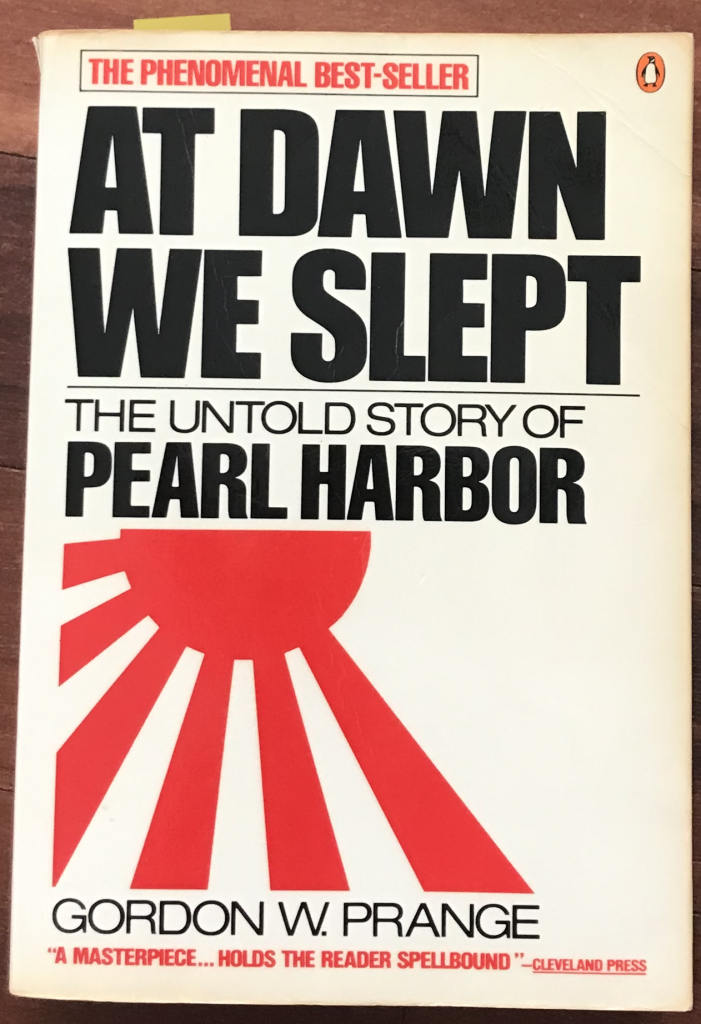
The Untold story of Pearl Harbor by Gordon W. Prange
This monumental work is the classical reference for any study of the Dec, 7th 1941 attack. It presents the raid in the overall Political and Military situation of late 1941.
The emphasis from the author is the view from the different Staffs. However the IJN Senior Officers testimonies should have been carefully examined as they are not exempt from bias. Pearl Harbor was presented as an extremely successful operation to the Emperor and the Japanese people and it is not easy to provide a different opinion.This book does not conduct a critical review of the Japanese plan, execution and results.
Similarly, the review of the US Army and US Navy at Pearl Harbor is also focused on the leadership and particularly Admiral Kimmel, analyzing whether he was responsible of the disastrous outcome or just a scapegoat. However this controversy on the demotion of the Navy Admiral is given a disproportionate historical importance.
We can summarize the blames for the Navy Command:
It is interesting that the sanctions against the US Army Commander in Chief were less harsh despite more area of concerns:
But this controversy on the demotion of the Navy Admiral is given a disproportionate historical importance.
Link to the Editor’s page:
Prange, Gordon W. (1981) At Dawn we slept: The untold story of Pearl Harbor. Penguin Books ISBN 0-1400-6455-9
Dull, Paul S. (1978) A Battle History of The Imperial Japanese Navy: (1941 – 1945). United States Naval Institute ISBN 0-87021-097-1
Ehrengardt, Christian-Jacques. (2016) 7 Décembre 1941Pearl Harbor: Une victoire sans lendemain. LOS! Hors-série n°13
Fuchida, Mitsuo Shinsato, T. Douglas and Urabe, Tadanori. (2020) For that one day: The memoirs of Mitsuo Fuchida Commander of the attack on Pearl Harbor.eXperience ISBN 0984674500
Kinsey, Bert and Roszak, Rock. (2018) Attack on Pearl Harbor: Japan Awakens a Sleeping Giant. Detail and Scale Publishing ISBN 9781731132017
Prange, Gordon W. (1981) At Dawn we slept: The untold story of Pearl Harbor. Penguin Books ISBN 0-1400-6455-9
Skwiot, Miroslav and Jarski Adam. (2014) Kaga 1920 – 1942: The Japanese Aircraft Carrier. Kagero ISBN 978-83-64596-26-1
Skwiot, Miroslav. (2015) Soryu and Hiryu: The Japanese Aircraft Carriers. Kagero ISBN 978-83-64596-52-0
Stile, Mark E. (2011) Tora! Tora! Tora!: Pearl Harbor 1941. Osprey Publishing ISBN 978-1-84908-509-0
Stillwell, Paul. (1981) Air Raid: Pearl Harbor : Recollection of a day of Infamy. Naval Institute Press ISBN 0-87021-086-6
Werneth, Ron. (2008) Beyond Pearl Harbor, the untold story of Japan Naval Airmen. Schiffer Publishing Ltd ISBN 978-0-7643-2932-6
Willmott H.P. (2001) Pearl Harbor. Cassel ISBN978-0304358847
Zimm, Alan D. (2011) Attack on Pearl Harbor : Strategy, Combat, Myths, Deception. Casemate Publishers ISBN 978-1-61200-021-3
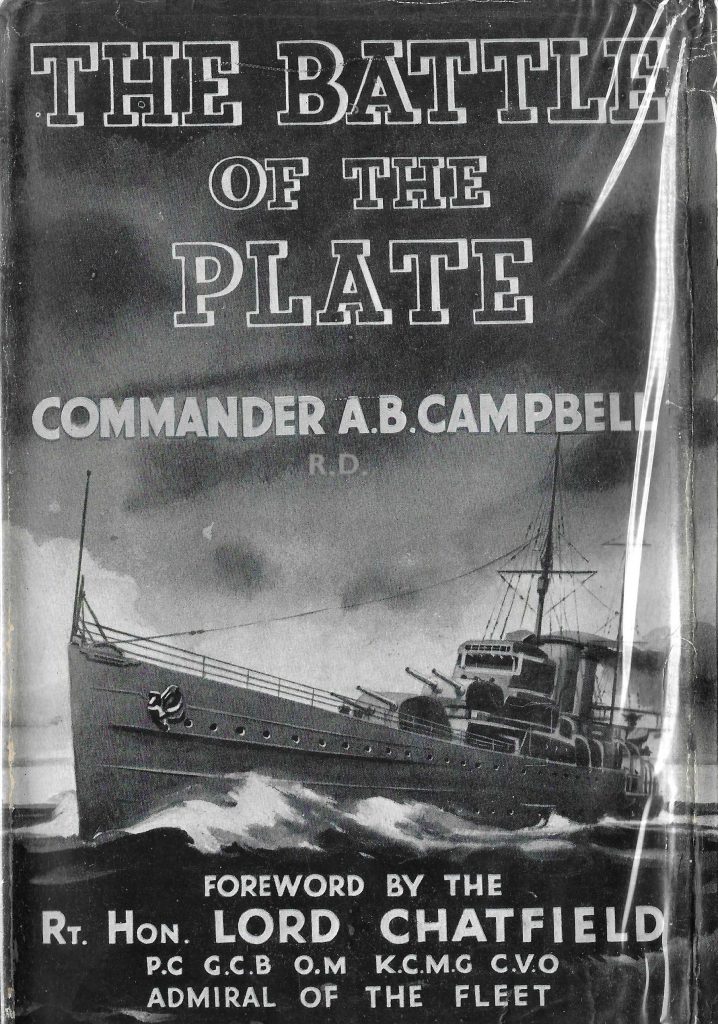
After WWI cruisers and battleship started carrying planes. Quickly the standard became a catapulted seaplane. The recovery was tricky and seaplane maintenance was heavy due open sea operations.
They were used for long range observation and patrolling as the radar was in his infancy with a limited range. Some Navies also developed the procedures to enable those floatplanes to assist with ranging for long distance gun firing.
The only usable air asset to the British Squadron based in the Falklands was the Fairey Seafox from HMS Ajax. The other Seafox was damaged. This explain the caution from the British side to commit and catapult the seaplane [1]p.63. Fortunately Lt Lewin pilot and Lt Kearney observer the airplane crew were extensively trained thru several missions looking out for U-Boats along the coast of Brazil.
It is interesting to notice that communication to the float plane was using a different frequency depending of the type of mission. For the Royal Navy the wireless frequency for reconnaissance missions was 230 kcs (KHz) and for spotting it was 3800 kcs (KHz). The longer wavelength (230 KHz) was enabling an extended range for transmission [2]p.128. Tuning in from one frequency to another was a complex process and unfortunately the information that the scouting Seafox was still on the 230 KHz channel was not passed to HMS Ajax communication team. The seaplane was catapulted around 6:40 and the frequency mismatch delayed the feedback from the scouting plane to 6:49am [2] p.150 and [1] p.76. There was further confusion between HMS Achilles and HMS Ajax burst which caused erroneous data to be fed back to the Dreyer tables of the HMS Ajax (mechanical firing computer). The full efficiency of the aerial scouting will start after 7:07am and last until 7:16 when the DKM Graf Spee broke the engagement with the 2 cruisers. During those 10 minutes most of the 20 6’ hits happened. Based on a firing cadence of 3 broadsides per minute it yield a success rate of ~5% at a range about 16 Kyards (15 km).
The scouting plane was also negating the effects of the smoke screens laid by the DKM Graf Spee. The changes in course were reported real time and the fire ranging were not interrupted.
The last mission for the Seafox was to inquire on the HMS Exeter status, as she was out of communication and inform the squadron commander Harwood that she survived the fight despite the hard hits. The successful recovery of the airplane made at 9:12am did not disrupt the pursuit of the DKM Graf Spee.
[1] Eric J. Grove (2000) The Price of Disobedience
Sutton Publishing ISBN 0750909277 / 9780750909273
[2] Dudley Pope (1956) The Battle of River Plate
McBooks Press ISBN 9781590130964
In the pre-radar time observation planes were providing an essential feedback to the Fire Control Officer. This was making the firing much more accurate over time.
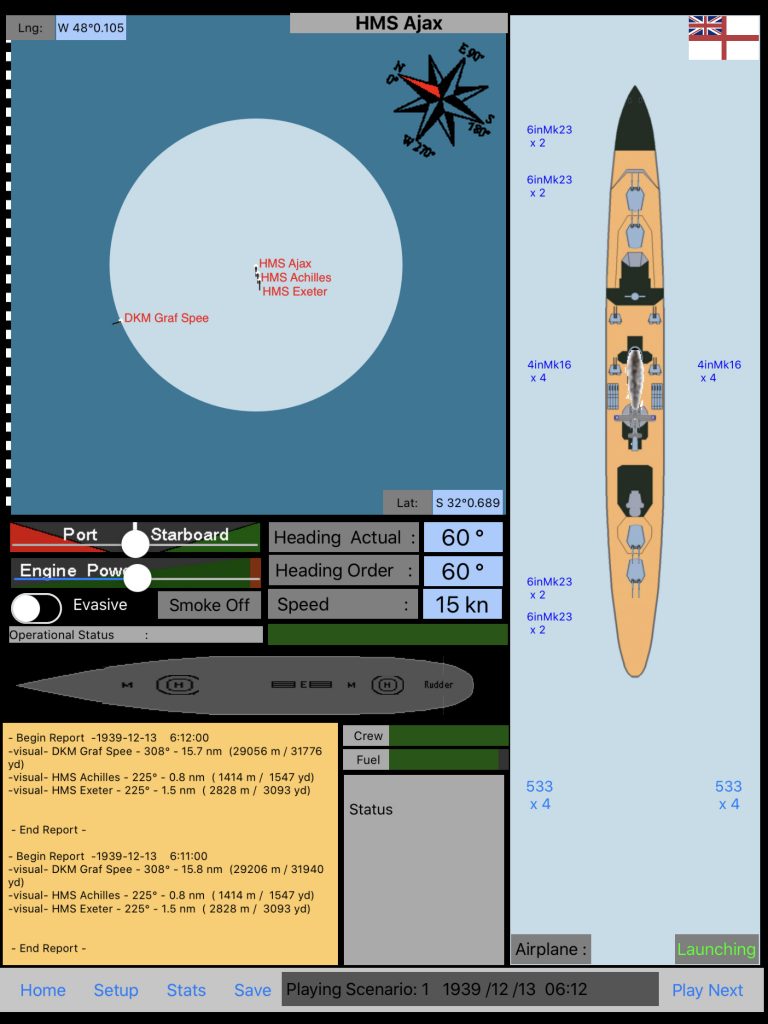
The first step is to launch the airplane, click the “Ready” button, the preparation of the catapulting is taking several minutes.
It will take also a few minutes once the airplane is in the air to establish the connection with the firing unit.
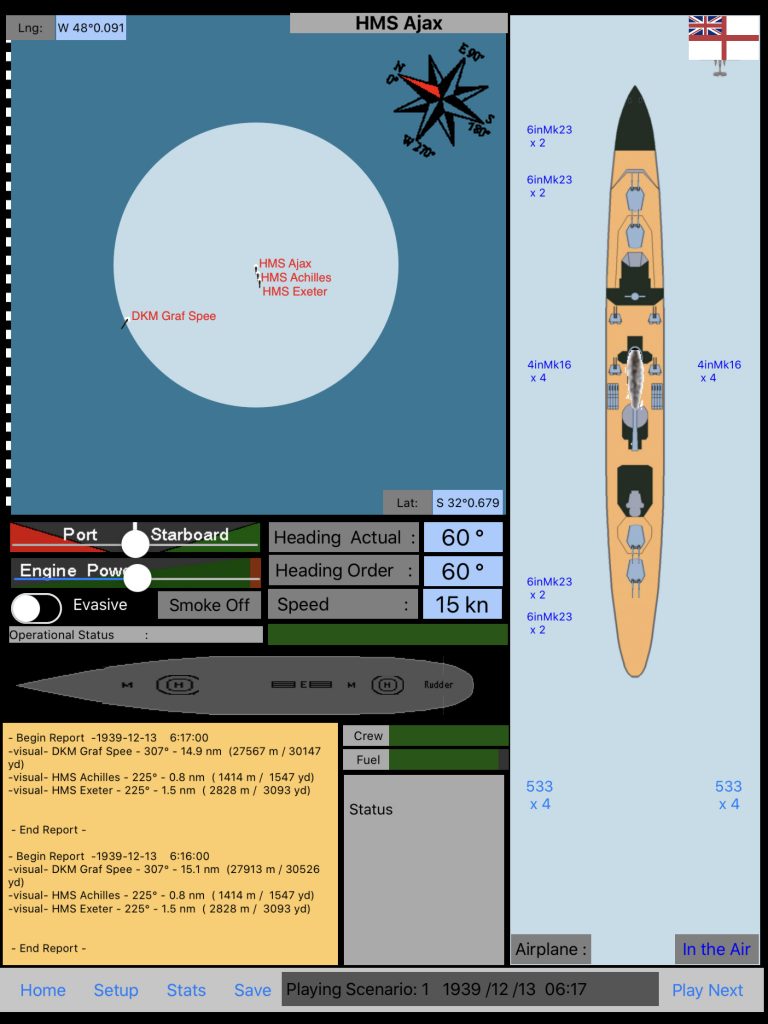
When the airplane is actively spotting you will have a special icon indicating an active radio connection.

During the launch phase, it is important to avoid direction changes as it could damage the plane.
The Operational Status summarize the overall combat worthiness of the boat. It is a combination of the power plant effectiveness, the accumulated damages to the structures (including the gunnery). Successive damages, by gun hit, torpedoes or bomb, will diminish the Operational Status down. The status bar will go from green to orange and ultimately red. Be careful to manage your units to keep them afloat, when the Operational Status is down to 0 your boat is a worthless sinking wreck!
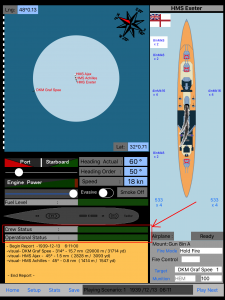
The Crew Status is a combination of the accumulated stress and fatigue. The Moral, Training and Experience of the crew will influence the wearing out of the Crew Status through the engagement. Hits and near misses will be the main contributors to the degradation of the Crew Status. A lower Crew Status will affect the overall efficiency of the crew (Gunnery, Repair Operation and launch / retrieve of observation planes).
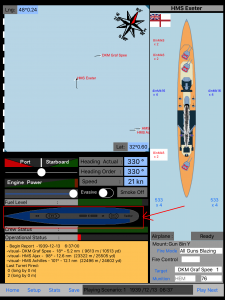
The boat flooding is represented on a schematic overview. Penetrating impacts on the belt or underwater will flood the hull, this flooding is limited due to the division in watertight compartments.
The map in the upper left corner of the screen is centered on the unit.
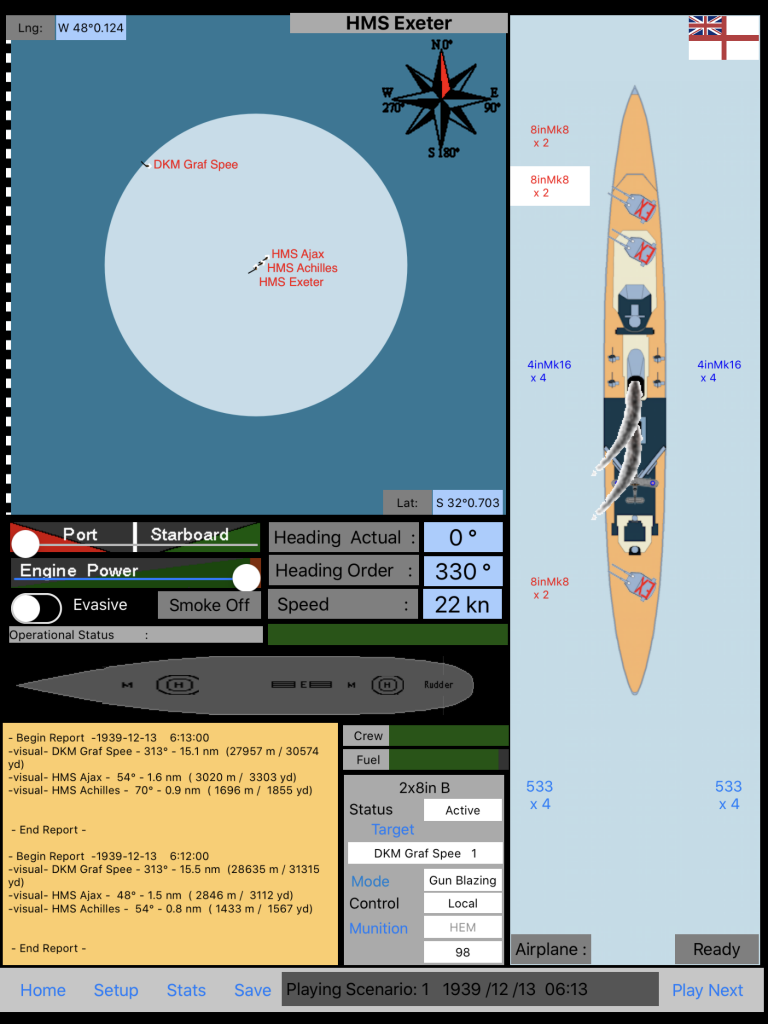
It is zoomable and there is a scale on the left side. The boat previous course is the black line and the white mustache is seized according to the speed.

Each bar is 1 nm (nautic mile). There is a compass providing directions and north alignment. The longitude (Lng) and latitude (Lat) are provided in the degree / decimal format.

The Heading cursor is below the Port / Starboard boxes. As you are displacing the cursor you will see the Heading order updated. The Heading order will be the unit direction at the next turn. Heading actual is the current heading.

The second cursor allows you to control the power. The speed up or down will be delayed due to the inertia of the boat. Boat speed are in nautical knots (kn), one knot of speed is one nautical mile per hour. Based on the power setting the Fuel level will decrease over time.
Evasive steering is controlled by a switch. When on, the boat will have a zigzag course. This was done to throw off the enemy gunnery and was quite efficient above a certain speed (~15 kn).
What is it about ?
DKM Graf Spee is a simulation of Naval Warfare. It will allow you to recreate the actual battle of the Rio de Plata and play also “what-if” scenario.
The game is turn based. Each turn duration is one minute and the turn start by orders for the Axis side and then orders for the Allied side.
How do I start to play?
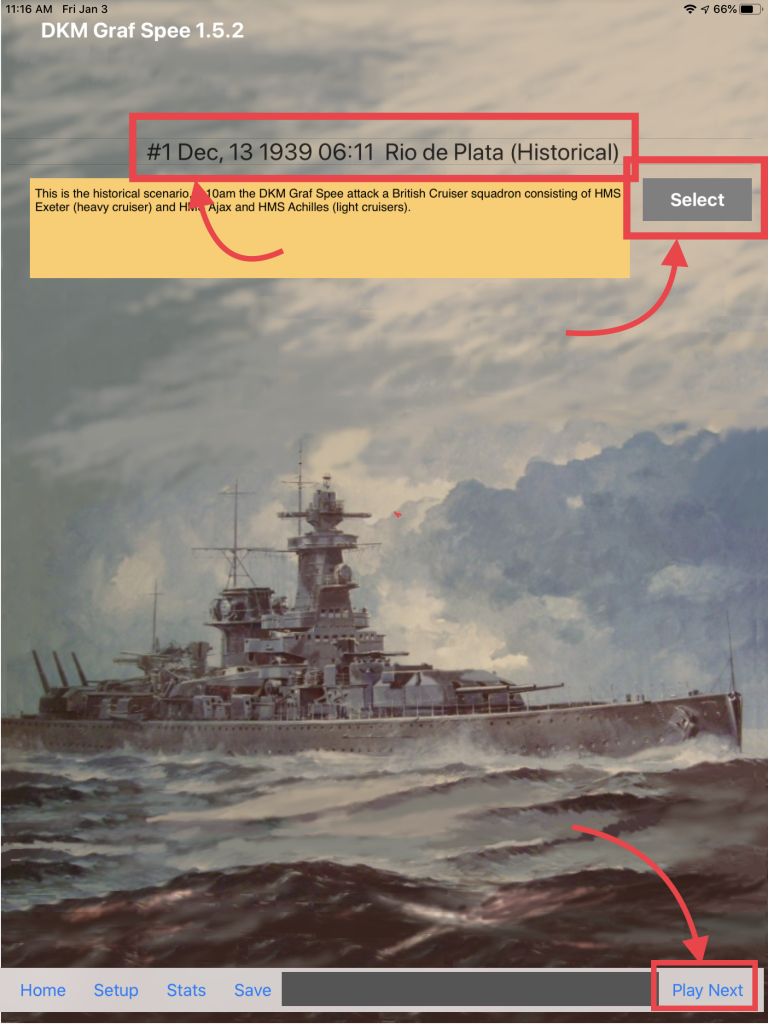
From the “Home” screen, choose one the scenario from the scrolling menu and read the short synopsis in the yellow tab. To load the scenario tap “Select”, At the prompt screen you will choose Continue (it will reset any game in progress)
We recommend the Scenario 1 (Historical Rio De Plata engagement), this way you can apply Commodore Harwood strategy.
The “Play Next” button will move screen to review the KriegsMarine main screen, another “Play Next” will provide the Allied (Royal Navy in this scenario) Main Screen.
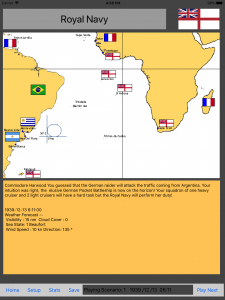
The main screen contain weather information in a scrollable window (last 5 minutes of info).
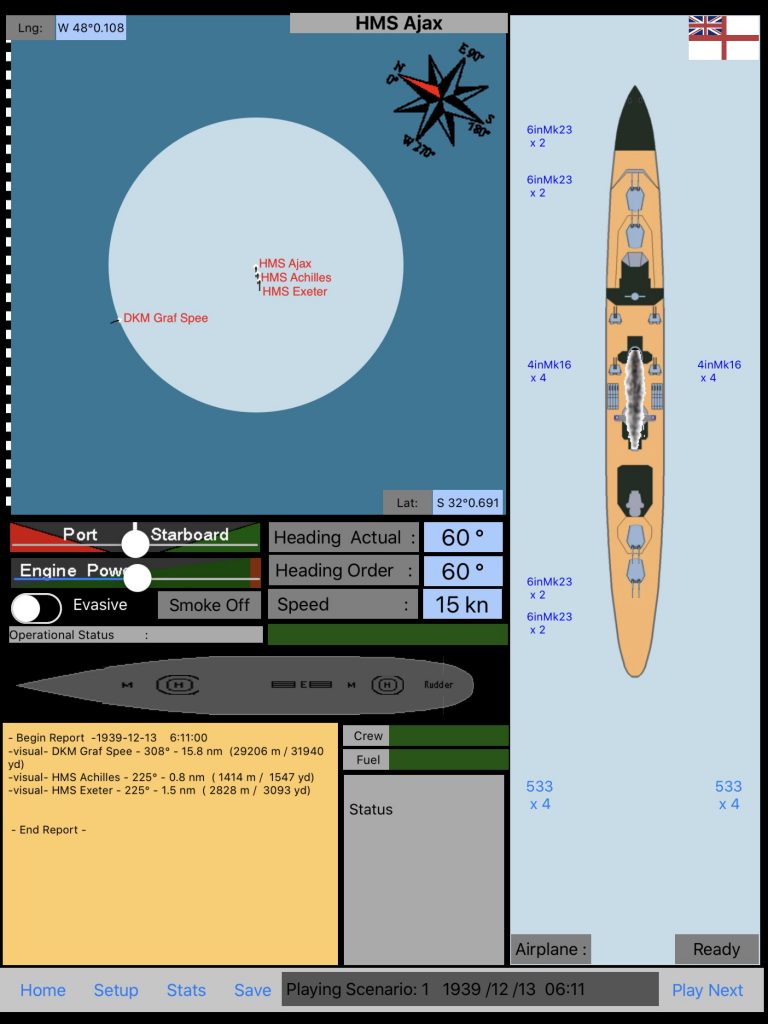
The “Play Next” screen will start your units review and orders
For detailed information see the following links:
Map, Speed, Heading and Steering
Observation Plane Instructions
The “Play Next” button will allow the review and orders to the 3 different units under your command in the scenario 1 (HMS Ajax, HMS Achilles and HMS Exeter).
After HMS Exeter all orders will be executed, including eventually gunnery resolution and torpedoes courses. The clock will tick one minute and the next turn will start.
Winning and Scoring
The goal of the allied Cruisers Squadron was to cause enough damage to the DKM Graf Spee to cripple her. Each boat has a point value which correspond to 100% of the operational value. The damage level required to cripple the DKM Graf Spee is 50% of the operational status. Your score (winning points) is the ratio of damages to the Graf Spee and total damages on your units.
For all information, please email info@softwim.com